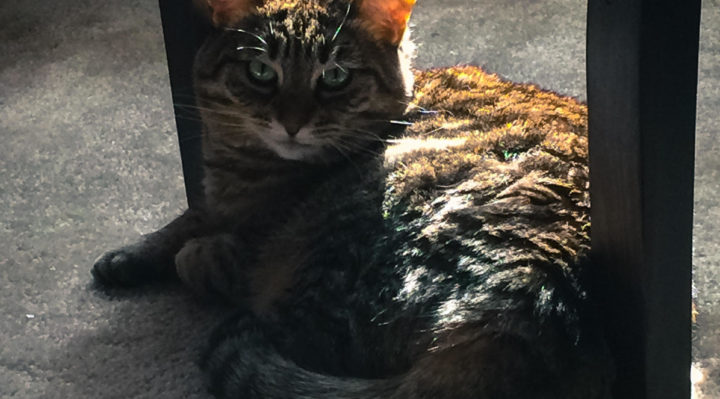
Emotional Support Animals—what’s legitimate and what’s not? Over the last few weeks, I’ve outlined the rules for traveling with an Emotional Support Animal in the cabin of a plane, without an extra charge, legitimately. It’s clear that not everyone follows the rules. It’s obvious that the scofflaws can endanger not only their fellow passengers on any flight they take, but also that those who travel with fake “certifications” and faux IDs may well affect the rights of access of legitimate ESAs in the future.
Here’s a true story of one person with an ESA who did it right:
My name is Blaine Stum. I was born and raised in Spokane Valley, Washington. I graduated from University High School and attended Gonzaga University for undergrad. I worked at the City of Spokane City Council for three and a half years before moving to Washington, DC, to pursue my master’s degree at the American University School of Public Affairs. I currently work as a researcher/policy analyst on criminal justice issues.
Years ago I was diagnosed with General Anxiety Disorder and Panic Disorder. While I’ve built some pretty effective and healthy coping mechanisms since then, I admittedly still have my ups and downs. So when my therapist and I would talk about ways to avoid or mitigate high-anxiety days/weeks/months, he mentioned that emotional support animals were incredibly helpful to some people and suggested I think about whether one could help me.
After a few sessions talking to him about it, I made the decision to get a cat for an emotional support animal. I knew I wanted a cat because as much as I love dogs, I don’t have the time, energy, or space to care for one. With a cat, I’d have an emotional support animal that is a little more independent.
When I went to look for cats, I actually walked into Petco on the South Hill and immediately saw a bunch of cats from SpokAnimal. They were all adorable, but there was one in particular that caught my eye. She was very quiet. She was lying on her bed inside the carrier and looked a bit more anxious than the other cats at that moment. It was that quiet anxiousness that drew me to her. I know anxiousness well. Maybe we could understand each other. Within 30 minutes, I was taking her home with me.
 Photo by Blaine Stum
Photo by Blaine Stum
Before I picked up Baby (my cat), I let my landlord know via email that I would be getting an emotional support animal, with the letter from my psychiatrist attached. After acknowledging receipt of my email, he sent a form for me to sign for his own records that waived the “no pet” policy for my unit. I had zero problems with my landlord at that complex, but I know that’s not the case for a lot of people.
Baby has been a major blessing for me. Cats are typically stereotyped as cold, aloof, and distant creatures, but that has not been my experience with her. . . . She’s super talkative, enjoys her play time with me, and loves to cuddle. Whenever I’m feeling more anxious than usual, she seems to know—she will hop onto the bed, rub my forehead, and cuddle with me for a while. It definitely helps.
When I decided to move, I didn’t want to leave Baby behind, so I decided I would take her with me. To do that, I had to contact Delta Airlines 48 hours before my flight to let them know I’d be bringing her along with me. I also had to submit the letter from my psychiatrist and an authorization form provided by the airline.
I was concerned that Baby wouldn’t do well because she would cry incessantly even during short car rides, and this was going to be 9 hours worth of flying and airports. A couple of weeks before the flight, I tried giving her a sedative from my veterinarian to see how she would react. She did not like it. At all. Much to my surprise, though, she didn’t need any sedative or calming aids. During the flights and layovers, she was incredibly quiet and well behaved.
While I could have taken Baby out during the flight and kept her on my lap, I decided to keep her in her carrier under the seat in front of me where I could see her and pet her. I made this decision for two reasons: 1) An airplane was a new environment for her, and I understood she could be easily frightened outside of the carrier; and 2) I know people are allergic to cats and did not want to assume the people next to me would want cat hair all over the place.
I did take her out of her carrier at airports during layovers, however. I brought some pads with me that she could use to go to bathroom if she needed to, as well as a little saucer for water and some food. She didn’t really need that, as she was too amused by all the people! (She’s a people watcher.)
I get upset when people don’t at least try to follow the rules for getting an emotional support animal. I understand that a lot of people aren’t as lucky to have the resources and support I’ve had, so I don’t ever want to be that person—the one who acts as a gatekeeper for others trying to get an emotional support animal. That said, when people find ways to game the rules or work around them, it can create the perception that all of us are doing it, or even worse . . . that we’re faking our mental illness to get a pet. It definitely doesn’t help us, especially given the stigma we already have to deal with.
If you’re thinking about getting an emotional support animal, talk about it with your therapist. Decide what type of animal would best suit your needs and current living situation.
Baby has been as supportive and loving as ever since we came to DC over a year ago. When I moved here, I barely knew anyone and was really anxious about not having a job in line. She was there for me every day, rubbing and cuddling.
The complex I’m at now has been great. I didn’t have any problems when I moved in or at any time since. And I managed to find a reasonably priced veterinarian who does home visits, so I don’t have to drive her anywhere. She loves the apartment, or as I call it, “Her Kingdom.” I spoil her, so she has great toys. She enjoys the shoelace the most, though . . .
▬▬▬▬▬▬▬▬▬▬
DOT [Department Of Transportation] operates a toll-free hotline to assist air travelers with disabilities. The hotline provides general information to consumers about the rights of air travelers with disabilities and responds to requests for printed consumer information. It also assists air travelers with time-sensitive disability-related issues that need to be addressed in ‘real time.’
1-800-778-4838 (voice) or 1-800-455-9880 (TTY)



